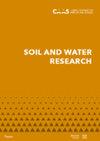工业残留物/废物的再利用是填埋场渗滤液污染地下水的可持续解决方案
IF 1.7
4区 农林科学
Q4 SOIL SCIENCE
引用次数: 1
摘要
为了增加废物和残留物的再利用,根据《废物框架指令》的要求,研究了废物、残留物和天然矿物作为低成本渗透反应屏障(PRB)材料的潜在用途。比较了餐厨垃圾堆肥、海泡石和钢渣与火山渣、浮石和活性炭对垃圾渗滤液中特定污染物的去除性能。实验表明,活性炭从垃圾渗滤液中去除了27%的铵(NH4+)、75%的化学需氧量(COD)和100%的磷酸盐(PO43-)、锌(Zn2+)和镍(Ni2+)。火山渣的COD去除率为50%,PO43去除率为100%,浮石的NH4+去除率为20%,Zn2+去除率为27%,COD去除率分别为65%和100%。还检查了反应性材料释放不需要成分的潜力,并表示不同水平的溶质(例如,PO43-、SO42-、NH4+)释放。在反应剂中,海泡石被发现是反应性材料,反映了较小的释放(例如Zn2+、Cd2+和Ni2+),但对Ni2+、COD、Zn2+、SO42-、Cl-、F-、NH4+和PO43-的去除效率分别为40%、50%、65%、95%、97%、98%和100%。结果表明,所研究的材料具有作为PRB系统处理高强度污染物羽流的反应剂的潜力。本文章由计算机程序翻译,如有差异,请以英文原文为准。
Reuse of industrial residues/wastes as a sustainable solution for landfill leachate contaminated groundwater
In order to increase the reuse of wastes and residues, as required by the Waste Framework Directive, the potential use of waste, residue and natural minerals as low-cost permeable reactive barrier (PRB) materials was investigated. The performance of a kitchen waste compost, sepiolite and steel slag was compared with that of volcanic slag, pumice and activated carbon in removing specific contaminants from landfill leachate. The experiments represented that the activated carbon removed 27% of the ammonium (NH4+), 75% of the chemical oxygen demand (COD) and 100% of the phosphate (PO43–), zinc (Zn2+) and nickel (Ni2+) from the landfill leachate. Volcanic slag exhibited removal efficiencies of 50% COD and 100% PO43– and pumice exhibited removal efficiencies of 20% NH4+, 27% Zn2+, 65% COD and 100% PO43–. The reactive materials were also checked for their potential in releasing unwanted constituents and represented different levels of the solute (e.g., PO43–, SO42–, NH4+) release. Among the reactives, sepiolite was found to be the reactive material reflecting a minor release (e.g., Zn2+, Cd2+ and Ni2+), but also delivering removal efficiencies of 40, 50, 65, 95, 97, 98, 98 and 100% for Ni2+, COD, Zn2+, SO42–, Cl–, F–, NH4+ and PO43–, respectively. The results show that the studied materials have the potential as reactives for PRB systems treating high strength contaminant plumes.
求助全文
通过发布文献求助,成功后即可免费获取论文全文。
去求助
来源期刊

Soil and Water Research
Water resources, Soil Science, Agriculture-WATER RESOURCES
CiteScore
4.60
自引率
0.00%
发文量
26
审稿时长
>12 weeks
期刊介绍:
An international peer-reviewed journal published under the auspices of the Czech Academy of Agricultural Sciences and financed by the Ministry of Agriculture of the Czech Republic. Published since 2006.
Thematic: original papers, short communications and critical reviews from all fields of science and engineering related to soil and water and their interactions in natural and man-modified landscapes, with a particular focus on agricultural land use. The fields encompassed include, but are not limited to, the basic and applied soil science, soil hydrology, irrigation and drainage of lands, hydrology, management and revitalisation of small water streams and small water reservoirs, including fishponds, soil erosion research and control, drought and flood control, wetland restoration and protection, surface and ground water protection in therms of their quantity and quality.
 求助内容:
求助内容: 应助结果提醒方式:
应助结果提醒方式:


